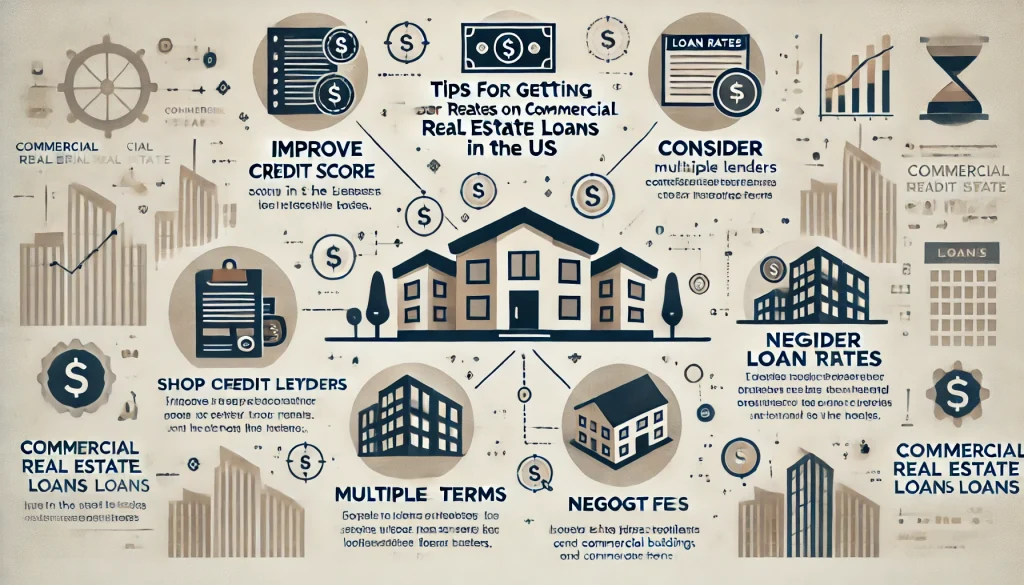Tips for Getting the Best Rates on Commercial Real Estate Loans in the US

When it comes to securing a commercial real estate loan, getting the best rate is critical for minimizing long-term costs and maximizing profitability. Whether you’re looking to finance the purchase of an office building, retail space, or industrial property, understanding how to navigate the complexities of commercial real estate lending is key. In this article, we will cover a range of practical tips that can help you secure the best rates on commercial real estate loans in the United States.
Table of Contents
1. Understand the Types of Commercial Real Estate Loans
Before diving into specific tips, it’s essential to understand the different types of commercial real estate loans. Each type of loan has its own rate structures, terms, and requirements. The most common types include:
- Traditional Commercial Mortgages: These are the most straightforward, fixed-rate loans that resemble residential mortgages.
- Small Business Administration (SBA) Loans: Specifically designed to help small businesses, SBA loans are government-backed and often offer competitive rates.
- Bridge Loans: These are short-term loans used to “bridge” gaps in financing, but they typically have higher interest rates.
- Hard Money Loans: These are asset-based loans that come with higher interest rates but faster approval times.
Knowing which loan best fits your needs will allow you to shop for the most favorable rates.
2. Improve Your Credit Score
Your credit score is one of the most significant factors lenders consider when offering loan rates. A higher credit score signals lower risk to lenders, allowing them to offer you better terms. The following tips can help you improve your credit score:
- Pay off outstanding debts: Reducing the amount you owe improves your credit utilization ratio, one of the main components of your credit score.
- Make payments on time: Consistent, on-time payments over several months or years will boost your score significantly.
- Avoid applying for new credit: Each application for new credit can lower your score temporarily, so avoid applying for new lines of credit before seeking a loan.
3. Shop Multiple Lenders
Just like with personal loans or mortgages, it pays to shop around when looking for commercial real estate financing. Different lenders will offer varying rates and terms based on your financial profile, the type of property, and the economic environment. When comparing lenders, consider the following:
- Traditional banks: They often offer the most competitive rates for well-qualified borrowers but may have stricter requirements.
- Credit unions: Sometimes more flexible than traditional banks, credit unions can offer lower rates, especially for local business owners.
- Online lenders: While rates may be higher, online lenders often have faster approval times and looser qualifications.
- Private lenders: These lenders are often more flexible but may charge higher interest rates due to increased risk.
Take the time to gather quotes from various lenders and compare the total cost, not just the interest rate. Include factors such as fees, loan terms, and prepayment penalties in your comparisons.
4. Negotiate Loan Terms and Fees
Many borrowers don’t realize that loan terms and fees are often negotiable, even in commercial real estate. While interest rates might be relatively fixed based on your credit profile, other aspects of the loan can be tailored to suit your needs. For example:
- Origination Fees: This fee is typically a percentage of the loan amount, but lenders may reduce or waive it if negotiated.
- Prepayment Penalties: Some loans include penalties for paying off the loan early. Negotiating lower or no prepayment penalties can save you a significant amount if you plan to sell or refinance the property before the loan term ends.
- Amortization Schedule: A longer amortization schedule will lower your monthly payments, but a shorter schedule can reduce the total interest paid over time. Negotiating terms that align with your financial goals can lead to long-term savings.
5. Consider Loan-to-Value (LTV) Ratios
Lenders use a loan-to-value (LTV) ratio to assess the risk associated with your loan. The LTV ratio is calculated by dividing the loan amount by the appraised value of the property. For example, if you’re borrowing $750,000 for a property appraised at $1,000,000, your LTV ratio is 75%.
A lower LTV ratio indicates less risk to the lender, which can result in better interest rates. To lower your LTV ratio:
- Make a larger down payment: A higher down payment reduces the loan amount, improving the LTV ratio.
- Increase the appraised value: If you can increase the property’s value through improvements or renovations before the loan application, it will improve your LTV ratio.
6. Maintain a Strong Debt Service Coverage Ratio (DSCR)
The debt service coverage ratio (DSCR) is another critical metric lenders use to assess risk. The DSCR is the ratio of your property’s annual net operating income (NOI) to the annual debt service (the total amount of principal and interest paid on the loan). For example, if your NOI is $100,000 and your annual debt service is $80,000, your DSCR is 1.25.
Lenders generally prefer a DSCR of 1.2 or higher. A higher DSCR indicates that you have sufficient income to cover your loan payments, reducing the lender’s risk and possibly lowering your interest rate. To improve your DSCR:
- Increase property revenue: This can be achieved by increasing rents, finding new tenants, or reducing vacancy rates.
- Reduce operating expenses: Streamlining operations and lowering costs will increase your NOI, which improves your DSCR.
7. Lengthen Loan Terms
The term length of your loan can also affect your interest rate. Longer-term loans often come with slightly higher interest rates but lower monthly payments. On the other hand, shorter-term loans can have lower interest rates but higher monthly payments. Depending on your cash flow needs and investment horizon, you might want to consider a longer loan term to keep monthly costs down, even if it means paying slightly more in interest.
- Long-term loans: Typically offer lower monthly payments but higher overall interest costs.
- Short-term loans: Have higher monthly payments but result in lower total interest paid over the life of the loan.
8. Prepare Strong Financial Documentation
Lenders want to see a solid financial history before offering competitive loan rates. When applying for a commercial real estate loan, be prepared to provide comprehensive financial documentation, which may include:
- Tax returns: Lenders often request the past two to three years of tax returns for both the borrower and the business.
- Profit and loss statements: A detailed statement showing your company’s profitability will help the lender gauge risk.
- Balance sheets: Lenders use balance sheets to understand your assets, liabilities, and equity.
- Cash flow statements: A strong cash flow statement reassures lenders that you can meet your loan payments.
Preparing these documents well in advance and ensuring they are accurate can speed up the loan process and help you secure the best rates.
9. Improve the Property’s Appeal
Lenders consider the condition and location of the property when setting interest rates. A well-maintained, attractive property in a desirable location presents less risk than a deteriorating property in a declining area. To make the property more appealing to lenders:
- Invest in improvements: Upgrading the property before applying for a loan can increase its value and make it easier to secure favorable terms.
- Focus on location: Properties in high-demand areas generally attract better loan terms. If you’re not in a prime location, highlight any positive aspects of the area, such as recent economic growth or upcoming developments.
10. Monitor Economic Conditions
Interest rates fluctuate based on broader economic conditions. In a rising interest rate environment, securing a fixed-rate loan quickly can lock in a lower rate before they go up further. Conversely, if rates are expected to fall, you may want to hold off on locking in your loan.
Stay informed on key economic indicators such as:
- Federal Reserve interest rate policies: The Federal Reserve sets the benchmark rate, which influences commercial real estate loan rates.
- Inflation: Rising inflation can lead to higher interest rates, while low inflation might mean lower rates.
- Market demand: High demand for commercial real estate financing can drive up rates, while lower demand can make lenders more competitive.
11. Consider Interest Rate Caps and Floors
Some lenders offer interest rate caps and floors, especially in variable-rate loans. These can protect you from significant rate increases but may also limit how much you benefit from falling rates. Negotiating a favorable cap or floor can save you money over the life of the loan.
- Interest rate cap: Sets a maximum interest rate that can be charged on the loan.
- Interest rate floor: Sets a minimum interest rate, ensuring that rates don’t fall too low, which is less favorable to the borrower.
12. Work with a Commercial Mortgage Broker
Navigating the commercial real estate lending market can be overwhelming, especially if you’re new to the process. A commercial mortgage broker can act as a middleman between you and potential lenders. Brokers often have access to a wide range of loan products and can help you compare rates and terms from various lenders.
The benefits of working with a broker include:
- Access to more loan options: Brokers can connect you with lenders that you may not have considered.
- Expert advice: Brokers understand the complexities of commercial real estate lending and can help you secure the best terms.
- Time savings: A broker can handle much of the legwork, saving you time and effort in finding the right loan.
Conclusion
Securing the best rates on a commercial real estate loan requires careful planning,
negotiation, and financial management. By improving your credit score, shopping around for multiple lenders, negotiating terms, and staying informed on market conditions, you can save significant amounts of money over the life of your loan. Whether you’re a seasoned investor or a first-time commercial property buyer, following these tips will put you in the best position to secure favorable loan terms.



1 thought on “Tips for Getting the Best Rates on Commercial Real Estate Loans in the US”